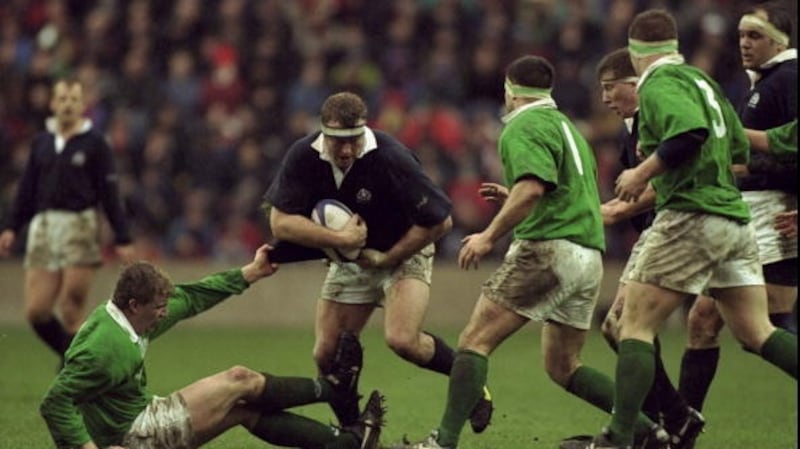Born: July 4th, 1970
Died: November 26th, 2022
Doddie (George) Wilson Weir, who has died aged 52 after suffering from motor neurone disease (MND), was an old-school rugby union player whose career straddled the amateur and professional eras. For the former Scotland and Lions lock forward, the game was a means of self-expression and fun as much as a job of work. Rugby for Weir was a serious business, but not that serious.
He won 61 Scottish caps in the 1990s, when he was a permanent fixture in the national side and, with his 1.98m (6ft 6in) frame and athleticism, he was marked out by the selectors from his early playing days at the Melrose club in the Scottish Borders.
READ MORE
It was at Melrose that Jim Telfer, the fierce disciplinarian coach, would oversee Sunday morning training sessions that the young Doddie would do anything to avoid, often hiding under the bedclothes before Telfer would phone him at home or, worse still, hammer on his front door. Weir’s playing career is peppered with stories about run-ins with Telfer, who would coach him at Scotland and with the Lions.

A good-humoured man with a lust for life, Weir responded to the blow of the diagnosis of his illness in 2016 by raising millions through a charity, My Name’5 Doddie Foundation, that he set up with his wife, Kathy, in order to fund research into MND. The five in its name came from the number on his Scotland shirt.
Born in Edinburgh, Doddie (George) was the son of Nanny (Margaret, nee Houston) and Jock Weir. His parents were farmers, and had three other children, Kirsty, Thomas and Christopher. Doddie was educated at Stewart’s Melville College and later at the Scottish Agricultural College. He began playing rugby seriously at Stewart’s Melville FP (former pupils) and by 1989 for Melrose. Still a teenager, he played a single game for the Scotland B team against Ireland at the end of that year.
A rangy athlete, he clearly displayed potential. The Glasgow Herald columnist Brian Meek wrote: “Melrose’s Doddie Weir still looks like he should eat more porridge but his jumping and catching are a joy to watch.” By the following year he was in Scotland’s pack for the game against Argentina at Murrayfield.
It was Weir’s ability in the lineout that stood out. The Scottish rugby writer Norman Mair observed later in 1990 that he could not recall anyone who had been propelled so high into the air as Weir on Scotland’s tour to New Zealand. In those days, before the bulking-up of the professional era, Weir weighed a mere 92kg (14st 7lb), which helped the lifters in the lineout, but the New Zealanders spotted something in the slender visitor. Waikato asked him to stay on and play for them for a couple of months, an honour bestowed to few visiting players in New Zealand and one that had previously been made to a young Martin Johnson.
Weir proved a versatile player, also turning out for Scotland at number eight, a third-row forward. When he moved south to the Newcastle club in 1995, the somewhat reluctant convert to serious weight training came under the influence of the fitness guru Steve Black.

The game had just gone professional: the club sent Black to the US to study conditioning in the world of grid-iron football, and even Weir was impressed. Newcastle were at the forefront of professionalism in the English club game, breaking a 12-month moratorium imposed by the Rugby Football Union at Twickenham to attract a host of top players.
Professionalism was a spur that helped Weir become selected for the triumphant Lions tour to South Africa in 1997, by which point he had added a physical edge to his play, immortalised by the TV commentator Bill McLaren’s famous description of Weir being “on the charge like a mad giraffe”. Weir always played up to the joker-in-the-pack role, but he sometimes resented his “daft laddie” image and became intensely competitive. On that tour Telfer trained his packs to counter the powerful scrummaging of the South Africans. But Weir was destined not to play in Johnson’s Test side.
In a midweek game against Mpumalanga the home lock, Marius Bosman, callously stamped on Weir’s knee, ending his tour and threatening his playing career. Weir recovered, but could never forgive Bosman – although he gave himself the satisfaction of naming a hedgehog-shaped shoe-scraping brush outside his door back home after the South African, so he could stamp on him every day.
His final Scotland match came against France in 2000, and two years later he left Newcastle to end his playing days in a spell with Border Reivers. Then Weir returned to life on a farm and part-time work as a commentator and after-dinner speaker. He also worked as a commercial director for a waste-management firm set up by his father-in-law.
In 2019, Weir was appointed OBE for his charity work and won the BBC Sports Personality of the Year Helen Rollason award for outstanding achievement in the face of adversity. In Scotland he was a folk hero for whom the phrase “larger than life” could have been coined. Earlier this month the biggest cheer of the afternoon at Murrayfield came when he entered the field of play dressed in a familiar blue and yellow tartan suit with his family before Scotland’s game against the All Blacks.
He married Kathy Huchinson in 1997. She survives him, along with their sons, Hamish, Angus and Ben, his siblings and his father.
– Guardian












